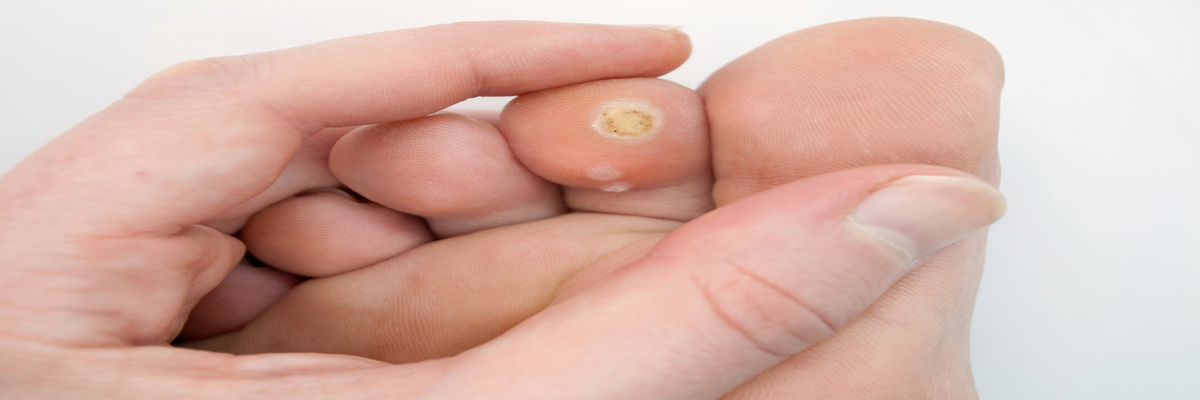Having small lumps on the feet is a sign of verruca vulgaris, a foot condition caused by HPV (a viral infection that spreads through close skin-to-skin contact, causes genital warts, and various types of cancer). While it gets better on its own, it requires medical attention to prevent its complications. Learn everything you need to know about verruca vulgaris in this article. Get a consultation with the best Podiatrists in Brooklyn.
What is a verruca vulgaris?
The human papillomavirus (HPV) causes verruca vulgaris (HPV). However, only HPV 1, 2, 4, 27, and 57 strains are responsible for verruca vulgaris. Papules are small, hard bumps that appear on the surface of the foot. They are caused by a viral infection that makes the epithelial cells grow too fast and thicken.
Plantar warts are another name for verruca vulgaris, which appear on the plantar surface of the foot, also referred to as the sole.
HPV isn’t extremely contagious, but a damp environment can make the transmission of the illness more difficult. Contact between bare feet and HPV-infected surfaces in changing rooms and shower cubicles can transfer the infection to new victims. Even if the virus isn’t in the body, it can live for more than a year. Warts of the verruca vulgaris variety are among the most prevalent and can strike anyone at any age. Most people first develop warts, including verruca vulgaris, during their adolescent or young adult years.
Immunosuppression increases your risk of developing a verruca vulgaris as well. Due to a transplant or other medical condition, you may be taking immunosuppressants, or you may be receiving treatment that weakens your immune system, such as chemotherapy. Verruca vulgaris are more likely to develop if you have a disease that impairs your immune system, such as HIV/AIDS or some types of blood cancer.
Verruca vulgaris, especially in youngsters, can disappear on its own, but this can take some time. Only one in two verruca vulgaris will go away in children after one year. A verruca vulgaris in an adult may not go away for several years.
The most common methods of treating verruca vulgaris are over-the-counter and prescription drugs, freezing (cryotherapy), and, in rare cases, microsurgery.
How to find out if you’ve got verruca vulgaris?
If you notice a white growth on the bottom of your foot, you may have a verruca vulgaris. The verruca vulgaris may have a small black dot or dots in the center. Verruca vulgaris, also called “mosaic warts,” can show up on their own or with other verrucae.
It’s common for verrucae to be seen in parts of the foot that are subjected to a lot of stress, such as the balls of the feet. The verrucae often become flat due to the pressure.
However, verrucae can produce strong discomfort in the affected area of your foot if you put weight on it.
Verruca-like conditions
You should see your doctor if you notice any of the symptoms of verruca vulgaris, as there are many other disorders that might cause them. Corn, for example, is a somewhat common ailment.
- Calluses
- Corns
- A cancer of the verrucous squamous cell type
- Acne
- Actinic keratoses
- Lichen nitidus
- Keratoderma
- Lichen planus
- Seborrheic keratosis is a common skin condition
The most common methods for dealing with the verruca vulgaris
- Avoid going barefoot in public places to lower your risk of contracting verruca vulgaris.
- If you have a verruca vulgaris on your foot, don’t touch, pick at, or scratch it. Doing so could spread the infection.
- When swimming, wear a waterproof plaster or verruca sock over your verruca vulgaris.
- Wear flip flops when showering and changing in public areas.
- Do not wear someone else’s shoes or socks.
- Change your socks and tights daily to prevent the infection from spreading to other parts of your body.
- Don’t scratch your verruca if possible.
- Use a nail file or pumice stone designed specifically for the verruca area.
In other cases, such as when the verruca vulgaris isn’t giving you any discomfort, it’s not necessary to seek treatment. Many will go away on their own without any treatment, but it may take years.
Your doctor may prescribe verruca removal medication containing salicylic acid to get rid of your verruca. Before applying the medication, make sure to warm your feet up and remove any extra skin that has formed. At least 12 weeks (about 3 months) of daily application is required, and careful attention must be paid to the surrounding healthy skin. You should cease treatment if the surrounding skin becomes inflamed, red, or irritated. Talk to your doctor about your diabetes or poor circulation.
If you have any foot problems, visit our Podiatry Clinic at Doral Health and Wellness. At Doral Health & Wellness, we have Podiatrists with extensive education and expertise. Trauma to the tendons, muscles, and bones of the foot is quite common. It’s not a good idea to put off seeing Foot Doctor Brooklyn until you are in a lot of pain. Our address is 1797 Pitkin Avenue, New York, NY 11212. To make an appointment, please call + 1 718 367 2555 or send an email to info@doralhw.org.






